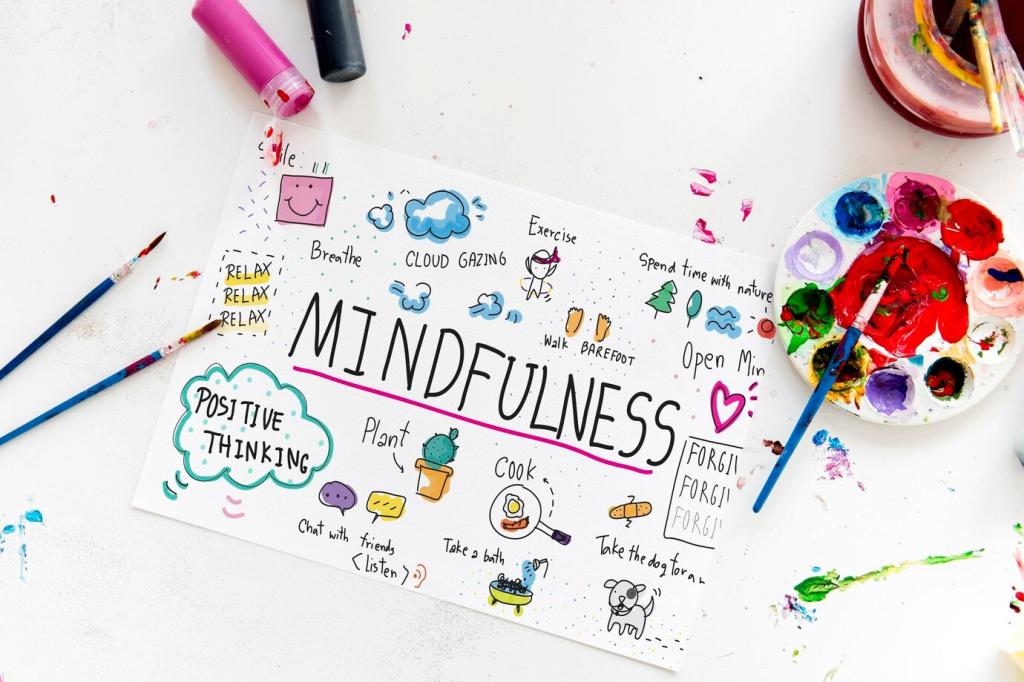
Mindfulness Techniques to Accelerate Personal Growth
Mindfulness is more than a trend—it’s a transformative practice that empowers individuals to live with greater awareness, clarity, and intention. By integrating mindfulness into your daily routine, you can unlock new levels of personal development, resilience, and well-being. This page explores powerful mindfulness techniques designed specifically to fast-track your journey towards greater self-improvement, offering practical insights and actionable approaches tailored for lasting change.

Mindful breathing is an accessible yet profound mindfulness technique that involves focusing your attention solely on your breath. By simply noticing the inhale and exhale, you bring your awareness out of distracting thoughts and into the steady rhythm of your natural breathing. This process helps to calm the mind, reduce stress, and creates a space where you can simply be. Practicing mindful breathing, even for a few minutes each day, can help you identify mental habits that hinder personal growth and establish a sense of stability, clarity, and self-compassion.

Sensory grounding draws your attention to the input from your five senses, encouraging a state of immersive awareness. Whenever you feel anxious or caught up in overthinking, tuning into the sensations of sound, touch, sight, smell, or taste can bring you back to the present moment. This technique not only provides immediate relief from racing thoughts, but also enriches your daily life, helping you notice small details and simple pleasures. Over time, sensory grounding builds your capacity for concentration and presence, two vital elements for accelerated self-discovery and growth.

Body scan meditation guides your focus through each part of your body, from your toes to the crown of your head. This technique increases your awareness of physical sensations, tension, or areas of discomfort, revealing where emotions or stress might be stored. By consciously observing these sensations with openness and non-judgment, you foster a deeper connection with your body and your emotional state. The body scan practice promotes relaxation, can improve sleep, and nurtures self-acceptance, serving as a springboard for meaningful inner change.
Transforming Thought Patterns
Noting and Labeling Thoughts
Noting and labeling is a mindfulness method where you silently identify the category of each thought as it arises. For instance, you might note thoughts as “planning,” “judging,” or “remembering.” This practice interrupts habitual identification with your thoughts and enables you to see patterns objectively. Instead of being swept away by your inner dialogue, you gain insight into which thoughts are supportive and which are limiting. Over time, noting and labeling strengthens self-awareness and develops the mental agility to respond to challenges with greater wisdom and intention.
Challenging Cognitive Distortions
Mindfulness provides a platform to notice and question deeply ingrained cognitive distortions—habitual ways of thinking that can undermine confidence and growth. By bringing curiosity to your recurring thoughts and exploring their validity, you begin to distinguish facts from interpretations or assumptions. When you catch yourself in catastrophizing or black-and-white thinking, mindful awareness offers the space to pause and reframe the narrative. This ongoing practice frees you from self-imposed limitations, allowing for new beliefs and opportunities to take root.
Cultivating a Beginner’s Mind
The concept of “beginner’s mind” in mindfulness is about approaching each thought and experience as if for the first time, free from biases and preconceived judgments. This openness fosters continuous growth, as it encourages learning, creativity, and receptivity to change. Maintaining a beginner’s mind involves noticing when you are making assumptions and consciously choosing to remain curious. By embracing this attitude, you inspire innovation and adaptability in yourself, which are essential qualities for anyone committed to personal development.
The RAIN Technique
RAIN stands for Recognize, Allow, Investigate, and Nurture, a widely embraced mindfulness practice for working with challenging emotions. When you feel upset or triggered, you start by recognizing what you’re experiencing and allowing the feeling to be present without resistance. Then, you investigate the sensation with kind curiosity, and finally, nurture yourself with compassion and understanding. The RAIN technique slowly rewires your reaction to emotional discomfort, transforming it into a source of learning and resilience, which accelerates your capacity for personal growth.
Self-Compassion Practices
Mindfulness-based self-compassion is about treating yourself with kindness and understanding when you encounter difficulties or make mistakes. Instead of resorting to harsh self-criticism, self-compassion involves acknowledging your shared humanity and responding with warmth. Regularly practicing self-compassion improves emotional stability, enhances motivation, and fosters a sense of safety within yourself, all of which are essential fuel for growth. By cultivating mindful self-compassion, you diminish barriers of fear and avoidance, making space for courage and change.
Observing Emotions Nonjudgmentally
A crucial aspect of emotional regulation is the ability to notice emotions as they come and go, without attaching labels like “good” or “bad.” This nonjudgmental observation develops emotional intelligence and helps you understand the origins and triggers of your feelings. When you stop fighting or suppressing emotions, you reduce their hold over your behavior and decisions. This freedom to simply observe leads to mature responses and deeper self-knowledge, both of which are vital for accelerating personal growth.
Previous slide
Next slide

